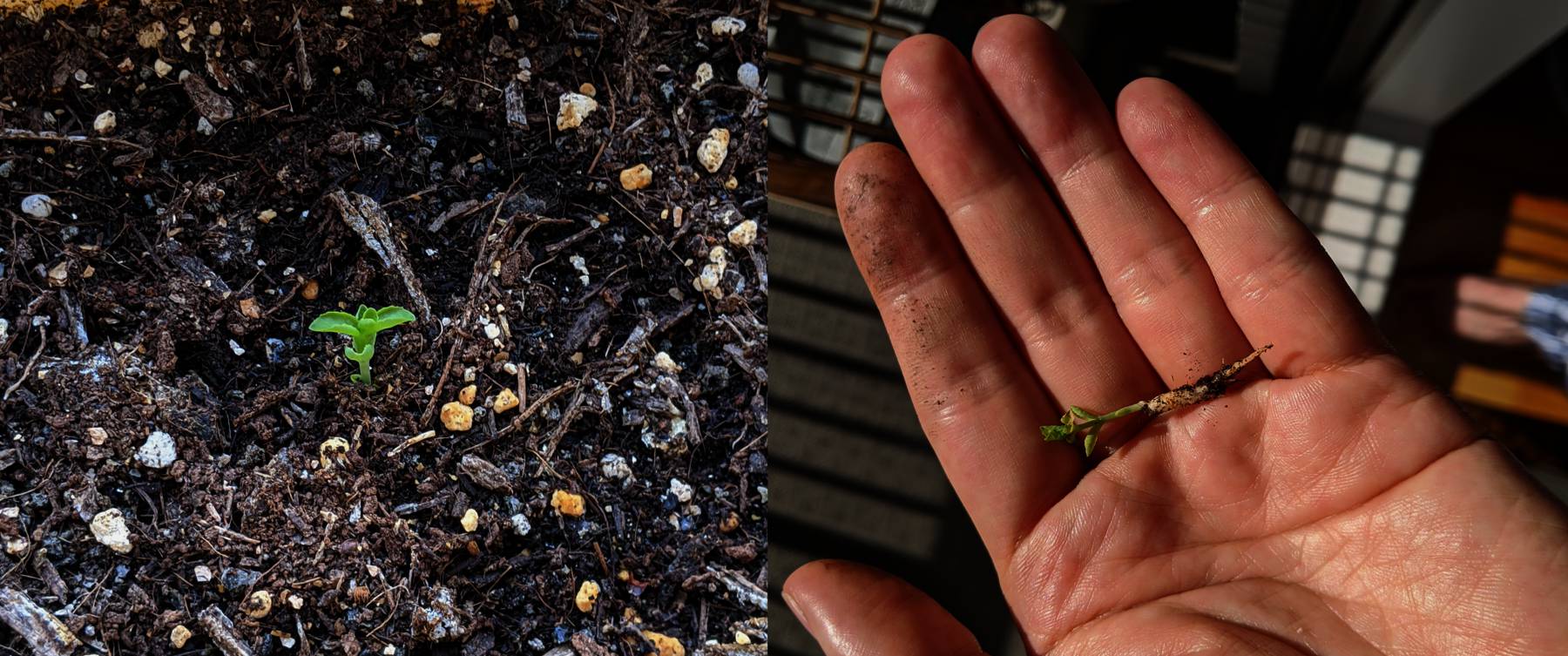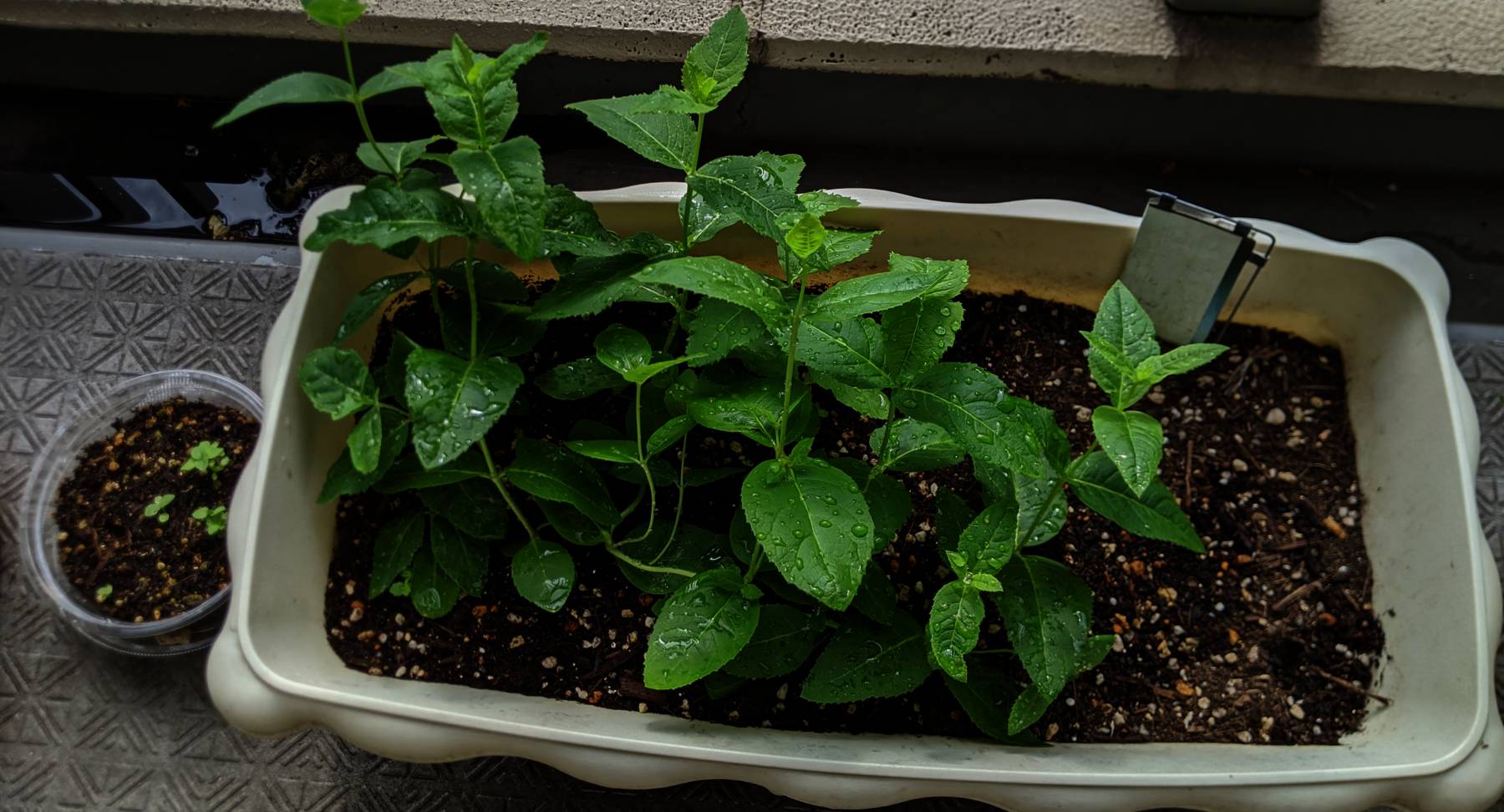桔梗花的種植與照顧
桔梗(學名:Platycodon grandiflorus),别名包袱花、鈴鐺花,擁有可愛的小花,帶有獨特的紙張質地和可見的花脈。我所在地區(日本東京)的常見品種有紫色和白色的花朵。這種植物的一個顯著特徵是它的花苞在完全打開之前像氣球一樣膨脹。
在超市或是居家賣場不難發現它們的身影。當我第一次發現它們之後我就決定要在我的陽台花園種個幾朵。
我在日本亞馬遜買了花的種子以後,用了我原本計畫要種些蔬菜的花盆來種。之後發現這種花盆不是最好的選擇,因為很難控制澆水的水量。之後會詳細解釋。
網路上有許多關於桔梗的資訊,但是關於它們在各個生長期的照片,還有如何照顧它們的文章非常的少。希望我的經驗分享可以對其他想要種桔梗的人有幫助!
桔梗在生長的初期長的非常緩慢
作為參考,東京的柯本氣候分類法分類裡面是「Cfa」,意思是溫暖帶濕地型夏季炎熱氣候。夏天最熱的時候可以高於 34 攝氏度。冬天的時候溫度最低可以低於零度,甚至有可能下雪。我買到的品種是較嬌小的「桔梗 五月雨 混和」,原生於北海道,所以極端的氣候對它們應該不構成問題。理論上冬天的時候它們會休眠然後隔年春天再重新長芽。根據種子包裝的說明,最好的播種季節是四月或是九月。

我第一次試圖種桔梗是在 2019 年九月。因為它們的發芽需要光照,所以最好把它們放在室外半日照或是有遮蔭的地方。我原本不知道它們在初期長的如此緩慢。大約在播種的二十天之後,種子們慢慢陸續發芽,然後用無比緩慢的速度生長它們的真葉。

在這個階段我面臨了另外一個問題,也就是要如何幫幼苗澆水。桔梗喜歡排水通暢的帶砂質土壤,所以我必須要維持土讓的濕度又不過度潮濕。問題是它們生長緩慢因此並不太消耗盆栽裡面的水。我所使用的盆栽是設計來保留較多水分的,所以反而是幫倒忙。很難估計多久要澆一次水,每次要澆多少。

另外一個問題是它們的生長季節不夠長。我猜測它們要儲存足夠的養分長出肥大的肉質根,才有機會在冬天嚴酷的休眠期存活。我懷疑它們一開始葉子會長的如此慢是因為都在長看不到的根部。結果在溫度變低之前,這一批桔梗來不及長到足夠的大小過冬。
冬天的時候桔梗高於地面的部份會枯死。維持耐心的等待,保持土壤溼潤,大約隔年的四月它們就會重新長出嫩芽。是的,大約就在我快要放棄並開始重新播種的時候。

春天開始播種讓事情簡單許多
我現在知道了,如果我一開始就等到四月才播種,結果也許不會改變太多。儘管它們一開始還是生長的非常緩慢,最終它們會爆發性的開始長葉子。
這次我把它們先種在雞蛋盒裡面,因為這樣子比較容易澆水。我建議使用底部澆水法,因為從上面澆水有可能移動幼苗,干擾它們的根部穩定。

春天相對溫暖的氣候似乎有促進幼苗的發展,但是跟隔壁的羅勒比起還是完全不在同一個層次。
它們的根毛開始從盒子的底部冒出,所以是時候把它們換到較大的盆子了。它們不喜歡根部被打擾,所以換盆的時候要小心操作,最好在幼苗長的太大之前進行。

換盆之後又過了兩週,它們開始有明顯的成長。原本換盆前就有的兩對真葉長的更大了,全部也都開始長第三對真葉。

大盆栽的另外一側是空的,因為我原本計畫要再種幾顆幼苗。為什麼呢?因為我本來以為要多種一點才會有足夠的花。畢竟你看,它們看起來就是只會有單一植株,單一朵花的模樣。很多網路上的圖片看起來它們都是叢生的樣子。我錯了!

桔梗單體可以長出多個側芽
換盆的一個月後,它們開始展現它們的主幹會橫臥的傾向。一開始這些主幹會垂直的生長,然後突然開始傾倒往旁邊發展,最後再垂直生長。
它們會朝四面八方生長,如果有人只看每一支幼苗的莖,是很難找到基部在哪裡的。

隨著它們越長越大,它們也開始從莖的節點或是基部長出新的分支。我開始理解很多圖片裡面看起來叢生的桔梗,其實很有可能都是同樣的一兩顆桔梗而已。

如果你仔細觀察的話,你可能會發現上面照片裡的葉子有一些小白點。我懷疑這些白點是一種真菌感染的疾病。幸運的是它們似乎沒有造成太大的影響。
桔梗第一年就有可能開花
我原本有點擔心我今年可能不會有任何的花,因為它們一開始長的好慢。結果,大約七月底的時候開始陸續有花苞長出來了。每天看著這些「氣球」越長越大我就感到興奮。

有一天,最大的那一個花苞開始出現些許的紫色。我知道它就快要開花了,但是是什麼時候呢?順帶一提,桔梗對日本人來說是秋天的象徵,看起來這些花還挺準時的。

隔天早上,這朵花就在我還在幫其他植物澆水的時候開了!

還有更多的花苞跟桔梗們繼續在生長。希望我今年春天會有更多的桔梗花可以欣賞!

你也種過桔梗嗎?你有沒有任何訣竅想要分享?歡迎寄電子郵件或是在底下留言 :)